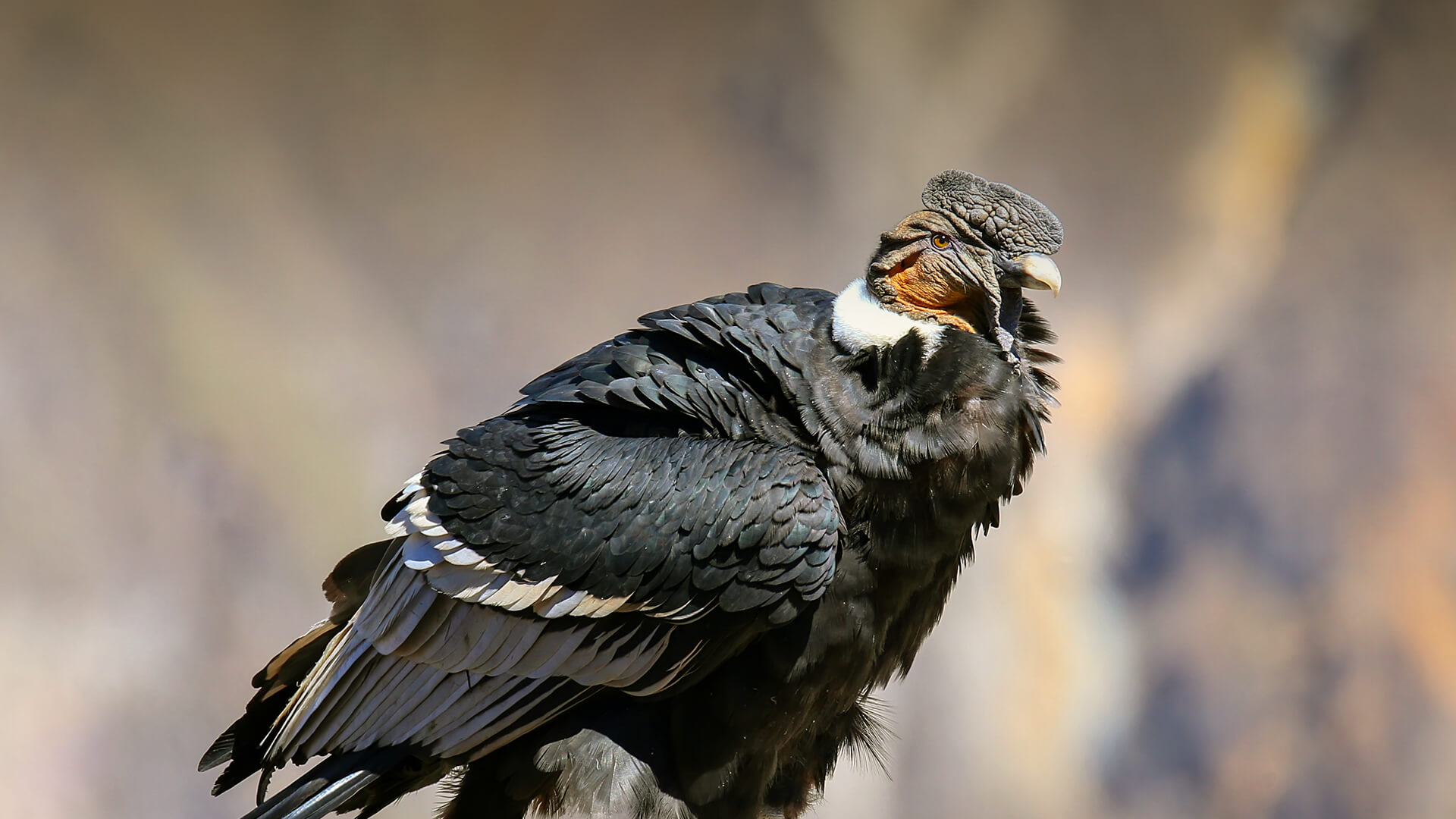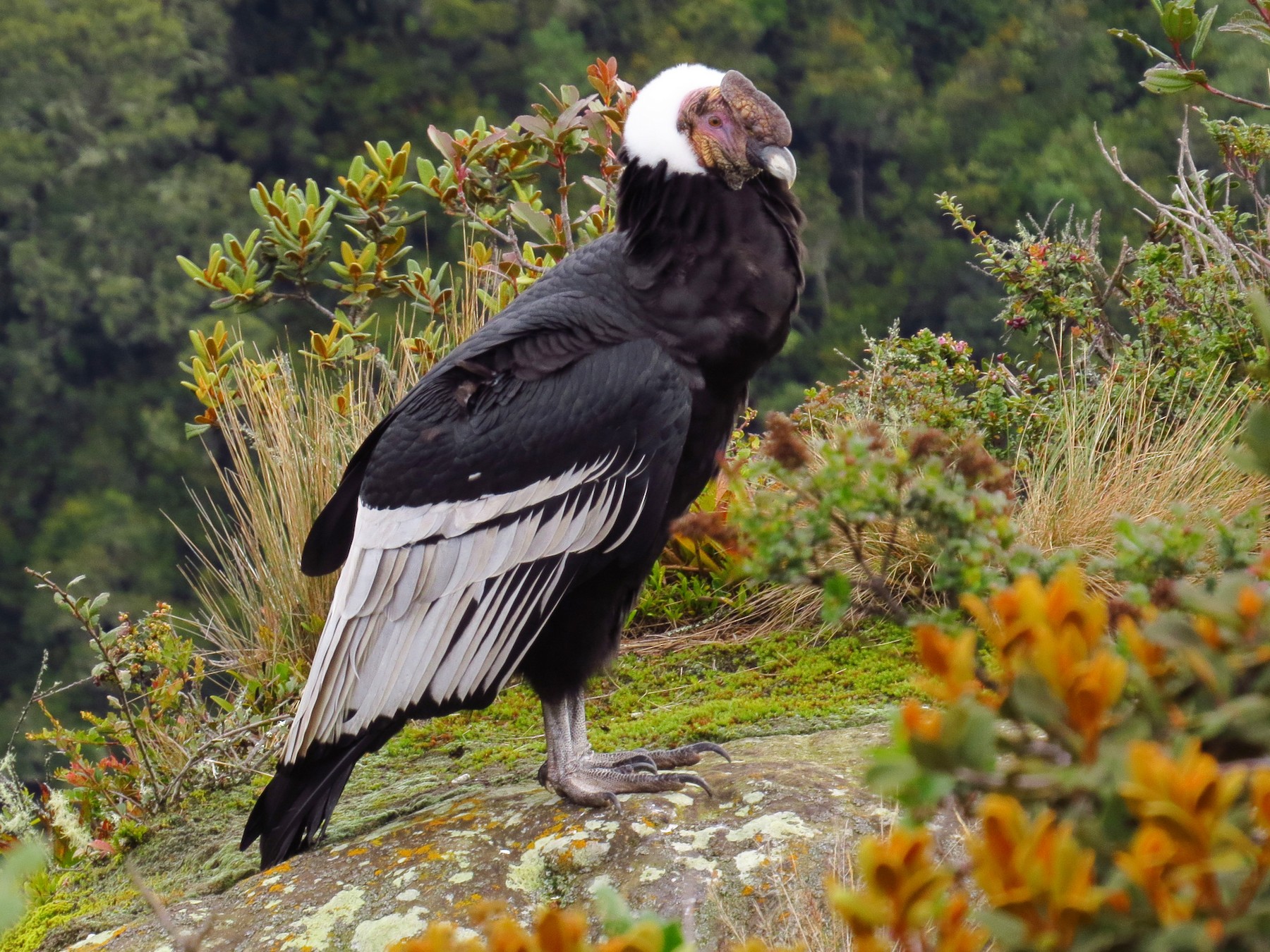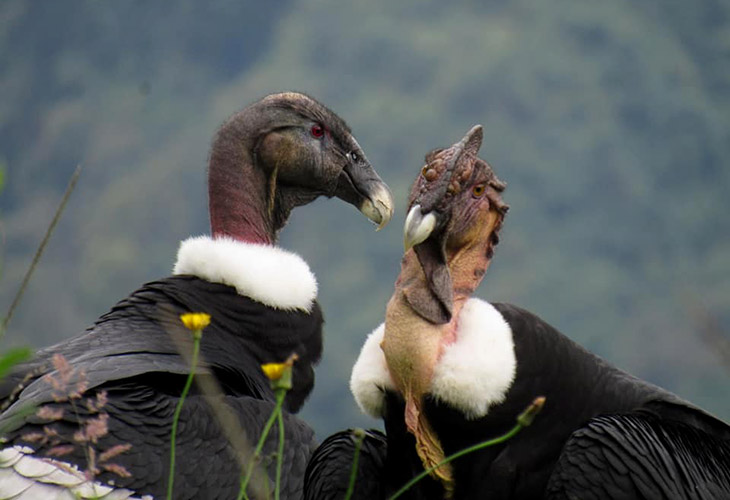San Diego Zoo Animals & Plants

ABOUT
Old bird from the New World. The Andean condor is the largest raptor in the world and the largest flying bird in South America. It flies majestically over the mountains and valleys of the Andes. This bird of prey and its close cousin, the California condor, are part of the New World vultures, a group of birds more closely related to storks than to the vultures of Africa.
Andean condors are the only New World vultures to show sexual dimorphism. Males are usually larger than females and have a distinctive comb on top of their head, as well as a large neck wattle and yellow eyes. The females lack the comb and have red eyes. The males keep the comb all their life, which makes it easy to tell the sex of an Andean condor chick as soon as it hatches. As adults, both sexes have black plumage with white secondary feathers and white neck ruffles. Juveniles have brown plumage and skin and don’t develop their adult coloring until they are about six years old.
Andean condors do not have a syrinx (similar to our larynx), so they cannot vocalize. Instead, they hiss, click, and grunt to communicate.
HABITAT AND DIET
Flying high. These impressive birds live in the highest peaks of the Andes. They nest in rocky crags and soar over open grasslands and lowland desert regions. When not scanning the landscape for a meal, the birds may roost in small groups, often stretching their enormous wings to catch some sun or preening.
Andean condors used to range in large numbers from the highlands of northern South America to the tip of Tierra del Fuego in the south. They tend to stay away from human disturbance, causing their range decrease dramatically. Today, Andean condors are most often seen in Peru, Chile, and Argentina, although a reintroduction program is taking place in Colombia.
The sky’s the limit. To find their food, Andean condors use their excellent eyesight and can spot a meal from high up in the air. They also look for clues to their next meal, such as other raptors gathering in one area on the ground or circling in the sky. Condors can glide over large areas while using little energy. These huge birds are too heavy to fly without help. They use warm air currents (thermals) to help them gain altitude and soar through the sky. By gliding from thermal to thermal, a condor may need to flap its wings only once every hour. When a condor stretches out its wings, the wing feathers look like outstretched fingertips. These “fingertips” let the condor make fine adjustments in flight, like wing flaps on an airplane.
A meal to die for. Like all vultures, Andean condors are scavengers and find most of their food after it is already dead. This lifestyle isn’t for everyone, but it does have certain advantages—the food can’t fight back! Like most other vultures, condors have a featherless head. This keeps the head from getting too messy while buried in a carcass. Condors have a high resistance to harmful bacteria, and their curved beak is good for tearing rotting flesh.
But as strong and impressive as an Andean condor’s beak looks, it is not as strong as the beaks of other birds of prey. After a condor eats, it rubs its head and neck back and forth across the ground to get all the “crumbs” off. These birds can consume more than 15 pounds (6.8 kilograms) of meat at one time, and may not be able to fly after such a large meal.
At the San Diego Zoo and San Diego Zoo Safari Park, the Andean condors eat rats, rabbits, beef spleen, trout, and ground meat, depending on the day. Although they are able to eat rancid meat, they prefer fresh food.

FAMILY LIFE
Watch out. Healthy adult condors have no natural predators and are vigilant when protecting their egg or chick. Humans have become non-natural predators. Ranchers poison livestock carcasses to ward off mountain lions and foxes; the poisoned carcasses kill the condors, too.
Look at me! The male Andean condor uses quite a display to attract his mate. He spreads his wings, clicks his tongue and hisses, and his neck turns yellow. If the female is impressed, the two find an appropriate nesting spot, usually in a shallow cave on a cliff ledge. The female lays a single egg, which the parents take turns incubating.
Baby makes three. Once the chick hatches, both parents are responsible for its care for over a year, well after the chick has fledged at six months. The young condor spends this time learning how to be a condor from its parents, everything from how to catch a thermal to what to eat and how to find it. Not until the condor is about six years old does it molt the brown feathers of its youth and grow the black-and-white plumage of an adult.

AT THE ZOO
Our first condors. Having an Andean condor at the San Diego Zoo in 1929 seems rather remarkable for the times. He was named Bum, and he was quite a character. Bum had been hand raised as a youngster in a zoo in Germany, so he was used to people and even liked to play with them. But since he had a large wingspan and a sharp beak, the humans had to watch their step. Bum’s favorite person was wildlife care specialist Karl Ring. When Karl came by, Bum hopped over to say hello. The two also had a favorite game in which Karl would lie down flat on his back so Bum could hop up to stand on his chest, wings spread.
Bum was soon paired with a young female from South America named Cleo. She was not nearly as friendly as Bum and hissed and charged at the wildlife care specialists, but Cleo and Bum got along famously. In July 1942, a male chick named Guaya was hatched and raised in his zoo habitat—believed to be the first Andean condor hatched in managed care in the United States! The world’s first incubator-hatched Andean condor hatched in May 1950. There were more exciting moments as the Zoo continued to hatch and raise Andean condors, leading to a successful reintroduction program for the birds.
Helping California condors. Our knowledge in working with Andean condors helped us prepare to save the critically endangered California condor. Andean condors were temporarily released in California to help test reintroduction techniques for their northern cousins as part of the California Condor Recovery Program. (The Andean condors were later brought back under human care and reintroduced in Colombia.)
CONSERVATION
Perilous prestige. Andean condors play a key role in a healthy, well-balanced environment because of their important role as nature’s recyclers. Consuming wildlife carcasses helps reduce the spread of diseases such as anthrax and botulism. Yet Andean condors are threatened over most of their range, both revered and feared by people. The condor is seen as a symbol of power, health, and liberty, and its bones and organs are used in traditional medicines. It is believed that the bird’s stomach cures breast cancer, roasted condor eyes improve eyesight, and a condor feather under the bed wards off nightmares.
Condors also appear in many South American myths. The Incas thought that the condor brought the sun into the sky every morning and was a messenger to the gods. There are also misconceptions about the condor’s role in the food chain, so condors are shot or poisoned to “protect” livestock. Condors also face threats from loss of habitat and reduced food sources.
High hopes. The good news is that Andean there are continuing successful efforts to restore the condor population in their native habitat. Michael Mace, curator of birds at the San Diego Zoo Safari Park, is the coordinator for the Andean Condor Species Survival Plan. Since 1989, 68 Andean condors, raised in American and Colombian zoos, have been reintroduced in Colombia, Venezuela, and Peru in an attempt to re-establish the birds in their range countries. By using satellites and radiotelemetry, Colombian biologists have been able to track and monitor the reintroduced birds and have found that they have survived, matured, and are now beginning to breed in their native habitat, a significant milestone of success for any reintroduction program.
In 1995, we received a significant achievement award for our Andean condor reintroduction program. This program will continue until Andean condors have recovered. We are also exploring other opportunities in South America where another reintroduction program could be developed.
Teamwork! One of the reasons for the survivorship of the reintroduced birds is public education and outreach. Condor “guards” from local communities teach condor natural history and conservation, and local school students learn to “look to the skies” through workshops in techniques such as biotelemetry (radio tracking), field notations, and the use of binoculars and spotting scopes. This provides a deeper understanding of why condors are important to the environment, Andean ecology, and their intrinsic value to the human community.
The Andean condor program is a shining example of what can be accomplished when there is cooperation between the public and private sectors, zoos and government agencies, field biologists, and aviculturists. The excitement and enthusiasm for Andean condor recovery is no less now than it was in 1989, when the first male condors flew out of the reintroduction aviary in Chingaza, Colombia.
The future for the Andean condor is much brighter now than it was when we began. These are birds that we can enjoy watching over the Andean peaks for many more years to come.
You can help us protect Andean condors by supporting San Diego Zoo Wildlife Alliance. Together we can save wildlife worldwide.





